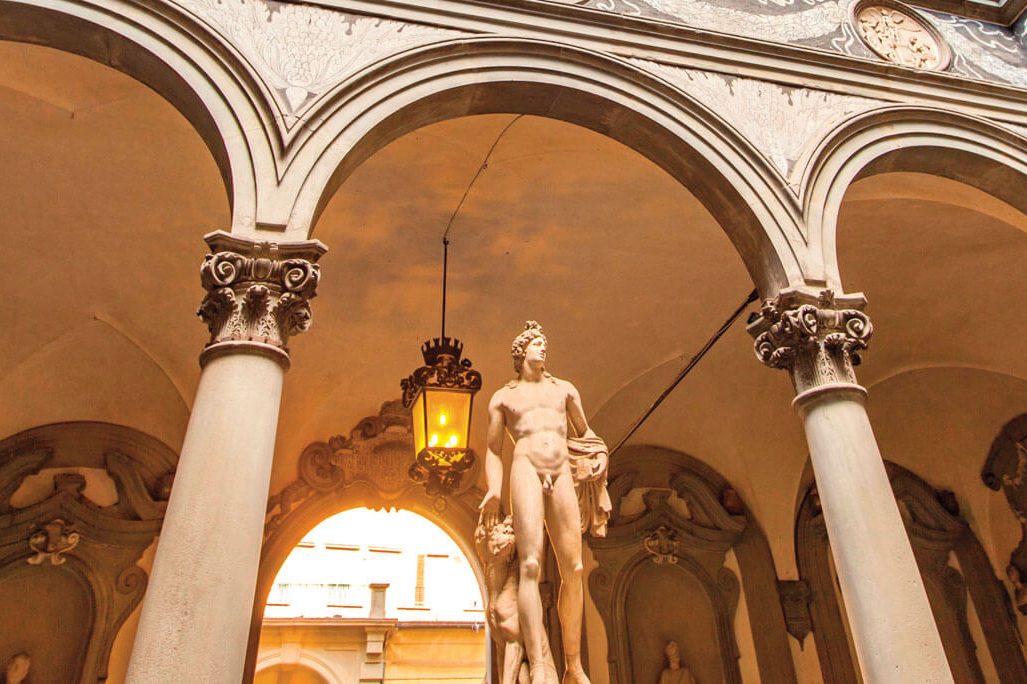Even though everybody in the world knows about Leonardo da Vinci’s great genius, relatively few people ever think about paying a visit to the Tuscan hometown from which he got his name. But in the tiny medieval hamlet of Vinci, not much far from Florence, the old houses and the unique landscape that surrounds them always remind you about the place’s most famous citizen, his life as an artist and the strong ties with the territory that inspired some of his earliest sketches.
A lonely country farmhouse, in particular, draws our attention, with its stone facade almost sunk in the midst of secular olive branches and surrounded by the grapevines of the Montalbano hills: just a few miles away from the outer walls of Vinci, in the nearby locality of Anchiano, stands this ancient building where Leonardo was born on April 15, 1452. And there is something extremely powerful and graceful about this solitary dwelling on a hill: all in all, it is a place quite literally “riddled with epiphanies”.
Turned into a museum in 1952, as part of the majestic celebrations for the inventor’s five hundredth anniversary of birth, the house was re-restored and brought to new life in 2012, with the addition of some digital attractions. As a matter of fact, to greet you when you enter the first room is now Leonardo himself, that is an impressive life-size hologram telling all visitors about the artist’s relationship with his native land. Similarly, the other rooms in the main building have recently been adorned with interactive screens reproducing virtual copies of the artist’s drawings and paintings, to be discovered and examined in every detail according to each visitor’s curiosity. In addition, a whole room located next to the ticket office is dedicated to a wall-sized projection of one of Leonardo’s most famous classics, The Last Supper.
The deep impressions that may well be left on the visitors’ mind, though, are all but relegated to the unusual digital transposition of this genius’ finest art: in fact, it is the house itself that somehow seems to hide in it the mystery behind Leonardo’s greatness. Just think about the ever so peculiar stone coat-of-arms of the da Vinci family, to be found precisely above the main window of the house: in the end, one cannot decide whether under that alleged helmet is a lion or a dog, just as one cannot always be sure about whether or not the Mona Lisa smiles. Ultimately, the origins of this genius seem to remain as unfathomable as the perfection of his masterpieces.

But what we may otherwise understand by a trip to Anchiano – and by our diving in a landscape that has survived almost untouched to this day – is how the Tuscan countryside framing Vinci has surely taught Leonardo what beauty actually looks like. You can experience that sensation too, for example by overlooking the whole valley below from the vantage point of that wooden Vitruvian Man sculpture atop of Vinci’s Museo Leonardiano. Or you can walk the so-called Strada Verde (Green Route) and follow for about three kilometers the old uphill path connecting the town to Anchiano through the olive trees. After all, this is the same route Leonardo himself might have used in his childhood – maybe accompanied by his father, Ser Piero – before the gifted child and his family eventually moved to Florence, where he began his career in Andrea del Verrocchio’s studio at age fourteen.
Leonardo has surely come a long way since those early days: indeed, the memory of his accomplishment in virtually every field of human knowledge is as lively today as it always has been. What still remains unbelievable is to know that such genius was born here, a miracle springing once and for all among these olives and these grapes. That’s why nobody touring this side of Tuscany should ever miss the opportunity to visit not only Leonardo’s native home, but its wonderful surroundings as well. In fact, it is not by chance that Vinci and five other neighboring towns are part of the itinerary called Le terre del Rinascimento (The Lands of the Renaissance): among them, Montelupo Fiorentino – hometown to the sculptor Baccio da Montelupo – and Empoli – where the birthplace of the painter Pontormo is – are definitely worth seeing.
But there is one last attraction to be seen before you leave Anchiano for other destinations. Halfway on the road to Vinci, in the solemn setting of Villa Il Ferrale, you should not miss the splendor of Leonardo. Una mostra impossibile (Leonardo. An Impossible Exhibition), an exhibit showcasing high-resolution same-size reproductions of this genius’ paintings, from the Lady with an Ermine to the Mona Lisa and so on: wonders scattered all over the world’s museums to be found here in one place, on the same hill where Leonardo was born.






























